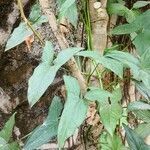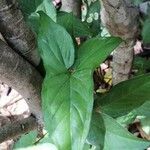Underground part a broad and flattened rhizome, to 5 × 2.5 cm, to 1.8 cm high, producing numerous small, fusiform offsets. Petiole green, 20-40 cm; leaf blade pale green abaxially, green adaxially, entire, cordate-hastate, ovate or deltoid in outline, 7-10 × 7-9 cm, terminal lobe ovate, basal lobes ovate to deltoid. Inflorescence appearing alongside leaves; peduncle pale green, 9-11 cm. Spathe convolute at base, green, ellipsoid to ovoid, 1.6-4 cm × 8-15 mm, distinctly constricted at apex; limb spreading, inside greenish purple to dark purple, ovate, 12-18 × 4-5 cm, long cuspidate. Spadix erect, subequaling spathe; female zone conic, 1.5-3 mm, 3-4 mm in diam. at base; ovary cream-colored; stigma sessile, reddish or pale pinkish; sterile zone 1.7-4 cm, proximal 7-8 mm covered with densely congested staminodes, rest naked, terete; staminodes ascending or variously curved, yellow or basal part reddish, narrowly fusiform, ca. 4 mm; male zone 4-9 mm; stamens yellow, subsessile; anthers orange; appendix narrowly conic, 10-13 cm, proximally corrugate, distally smooth, tapering to sharply acute apex, base truncate or obliquely truncate, usually with a stipe 5-7 mm. Fl. May-Jul. 2n = 52.
More
Small ?facultatively evergreen herb; rhizome tuberous, c. 2 cm diam., ovoid to spindleshaped, bearing several small, easily detached ovoid cormels. Leaves several together; petioles to c. 20 cm long, shortly sheathing; blades sagittate, c. 12 × 5 cm, deep bright green, membranous. Inflorescence among leaves, sometimes several in succession; peduncle much shorter than petioles; spathe to c. 20 cm long; lower spathe convolute, elliptic, to 3 cm long, greenish brown outside; spathe limb spreading, to c. 18 cm long, broadly ovate below, then long-acuminate, the distal portion often twisted, glistening velvety purple inside, greenish brown outside; spadix c. equalling spathe; female zone c. 0.8 cm long, then a 1 cm zone of crowded sinuous filiform neuter organs, then a naked interstice c. 2 cm long; male zone to 1.2 cm long; anthers with shortly beaked connective; appendix slender and tapering, faintly swollen at oblique base, to c. 15 cm long, rough to verruculose, purple-black. Infructescence within persistent spathe base.


